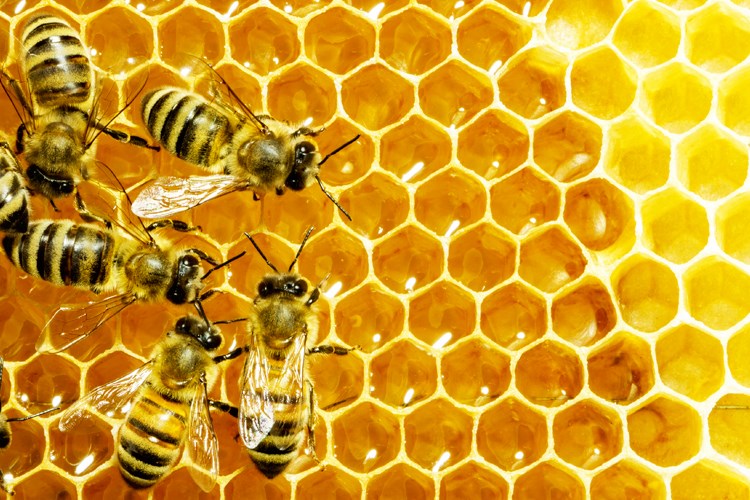While ‘murder hornets’ are dominating the headlines these days, they’re merely a distraction from the lurking, bigger invasive threat that has been quietly and systematically taking down honeybee populations across North America.
Meet the Varroa destructor mite. The name destructor says it all, for these mites have decimated bee populations everywhere. First documented in Asia in 1904, they were found in North America as early as the 1950s.
These mites are in the same family as ticks and spiders. They’re only about the size of a sesame seed but the fact that they can be seen without a microscope means they’re really big when compared to the size of their host, Apis mellifera, the common European honeybee. In human terms, a Varroa mite infestation would be like having a tick the size of a rat feeding on your back.
The Varroa mites are found everywhere in Canada except Thunder Bay and Newfoundland and Labrador. The Ontario Ministry of Agriculture’s website warns that if bees are kept anywhere outside these areas, they will be infested with Varroa mites.
The mites feed on the bees’ hemolymph (basically its blood) and fat tissue. The hemolymph transports a bee’s nutrients throughout its body, and the fat tissue contains its immune cells. In the process of removing bees’ natural immunity, Varroa mites also transmit deadly diseases. This includes deformed wing virus which results in shrivelled wings, bloated abdomen, learning problems and shortened life.
If left untreated, Varroa destructor mites destroy entire hives.
Paul Kozak, the provincial apiarist for Ontario, says the Varroa destructor mite is the main killer for honeybee colonies in all of North America. “This one mite is having devastating impacts throughout the world. They’ve changed beekeeping forever.”
An adult fertilized female mite enters a bee larvae cell just before it’s capped with wax. She then begins feeding on the larvae and lays eggs: first a male egg, then female eggs. Once the eggs hatch, the male mates with the females, and all the fertilized female mites emerge with the matured larvae. This bee is weakened and has a shorter lifespan. The mites move quickly from bee to bee. Once the queen stops laying larvae for the winter, the Varroa destructor mites then concentrate entirely on the adult bee population.
Ernesto Guzman, a professor of apiculture and the director of the honeybee research centre at the University of Guelph, says the mites were most likely introduced by importation of infested honeybee queens, either legally or illegally.
The mites continue to spread from colony to colony when infested worker bees share a flower with a noninfested worker bee from another hive, when an infested worker bee accidentally enters a foreign hive or when healthy bee populations attack infested hives for their honey, and in the process become infested. When a bee colony divides itself in to two colonies, a process called swarming, this also spreads the Varroa mites.
Although Varroa destructor mites have become resistant to many synthetically made miticides, Guzman said that without treatment, colonies have only a 50 per cent chance of survival through the winter when the infestation rate is higher than 6 per cent. That means only six mites per 100 bees are needed to reduce survival rates by half. Healthy colonies that are treated correctly and at the right time have an 80 to 90 per cent chance of survival.
“The objective is not to eradicate the mites. They will be here long after humans are gone,” said Guzman. “The objective is to keep their populations low.”
Guzman said there is some hope as research is demonstrating naturally occurring compounds, specifically essential oils including oregano, clove and thyme, are effective in controlling mite populations. So far, there is no evidence of the mites developing resistance. Research is still ongoing for the best application method.
Another area of research is in selective breeding for natural resistance. Bees have two different kinds of behaviours that are natural defences against the mites. The first is hygienic practices, meaning the worker bees can smell infected larvae under its wax cap. They uncap the larvae and remove it, and this way disrupt the mite’s life cycle. The other habit is grooming. Some bees can scratch off the mites and kill them.
Not all bees are born with these behaviours. Guzman’s lab is researching how to breed bees that have these traits.
“It’s important to keep populations of bees alive because one third of our food supply comes from the pollination work of bees,” said Guzman. “There are thousands of bee species in the world, and they all pollinate, but the most important pollinator in the world is the Western honeybee.”
Guzman cited a new generation of pesticides, other pests and diseases, the Varroa destructor mite, as well as the now common practice of transporting and renting bee colonies to pollinate crops, as new stressors that bee colonies and beekeepers weren’t dealing with 50 years ago.
“We’ve been losing colonies at a rate of over 30 per cent,” said Guzman. “Standards of living would be lower without modern practices, but they come with a price. Losing bees is one of those prices.
“Consume local honey. You are supporting local beekeepers, and they are the ones who can keep bee populations alive. But they need to be able to make a business out of it.”
Leah Gerber is a reporter for the Waterloo Region Record. Her reporting is funded by the Canadian government through its Local Journalism Initiative.
